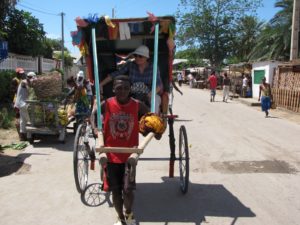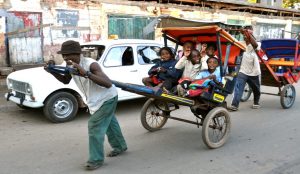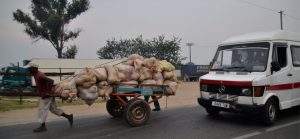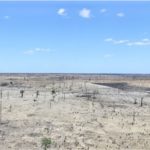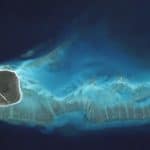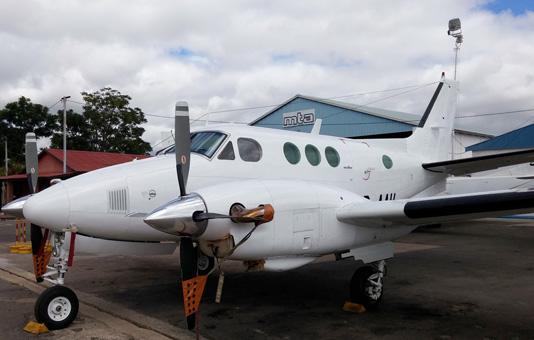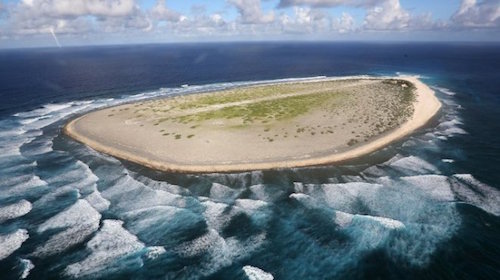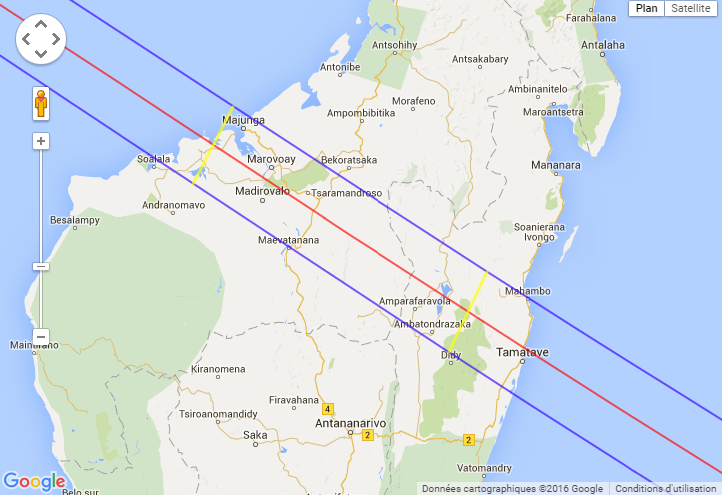Comfortably from A to B
Who has a Trip to Madagascar plans, who inevitably also thinks about how to get from A to B on the island. There is the possibility to get into one of the Shared cabs or to get into another motorized cab, however, this rather uncomfortable and not infrequently also very dangerous method of locomotion can basically not be recommended to anyone who is not absolutely dependent on it. Besides the motorized cabsIn addition to the cabs and commercial vehicles, which usually move forward under extremely adventurous conditions, there are also numerous non-motorized cabs and commercial vehicles in Madagascar, which will be examined in more detail below.
Pousse-Pousse - On the road on two legs
The so-called pousse-pousse are considered to be non-motorized cabs certainly the most unusual to the European eye. It is a means of transport that has been originally from the Asian region originates. Nowadays, it is no longer possible to fully reconstruct whether the pousse-pousse was introduced by the English, in the 19th century, who knew the means of transport from the Indian colonies, or whether the Chinese railroad workers, who had been brought to Madagascar during the French colonial period to take over the construction of the railroad there, used the Pousse-Pousse introduced have. Either way, the pousse pousse is about Companions pulled by people while walking. Accordingly, they strongly resemble a carriage, except that no horses are harnessed. Especially many Pousse-Pousse exist in Antsirabe, a city that can be found, for example, on our Tours via the RN7 can visit. There we offer among other things a Tour from Antsirabe to Ambositra on - a wonderful opportunity to Zafimaniry Villages and to get to know each other in a harmonious blend of culture, nature and adventure to recover. On this Journey through Madagascar would then necessarily catch your eye the pousse-pousse in Antsirabe, because there are estimated more than 6,000 of these vehicles on the road and transport customers from A to B during the day and at night. The owners of the non-motorized cabs are mostly Madagascans of Indian origin, who in turn use them for a Fee from 70 cents to the drivers so that they can earn their daily bread with cab rides. However, pousse-pousse are not only used to drive customers through the cities, but also to drive quite everyday errands to make. People take their children to school or take care of their shopping with the pousse-pousse. In some cases, people also use the vehicles to transport larger loadsIt is possible to move loads of up to one ton with the vehicles. In Antananarivo, for example, there is a narrower version of the pousse pousse, which is used exclusively for the transportation of goods.
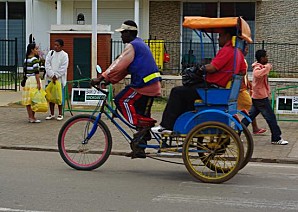
Rickshaws - Fast and comfortable
In addition to the pousse-pousse, a number of other vehicles exist that are used to transport travelers or goods. Increasingly popular in Madagascar are the classic rickshaws, pulled by bicycles. These vehicles are now also very modern in major German cities such as Berlin or Hamburg. The rickshaws in Madagascar all originate from India or Chinawhere they can be bought very cheaply, because they are no longer needed in these countries. The rickshaws are significantly faster than the pousse-pousse and at the same time much more comfortable for both the driver and the passenger. In addition, they are also more stable and thus also safer at the same time. If you have a Travel from Antananarivo to Tulear book with us and accordingly travel once from the central part of the country to the southern tip, you will visit many cities where you can have a Ride with a rickshaw can book.
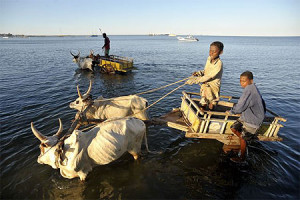
Zebu carts - Stable and powerful utility vehicles
Non-motorized goods transport is still an important issue in Madagascar today. Especially in the rural regions of the island, where people do not own any motorized vehicles, the zebu cart plays an important role. The Cart with the harnessed zebus transport building materials, bricks, vegetables, fruits and meat. Two zebu bulls are responsible for transportation. In particular on the west coast, in the south of the country and in the central highlands the zebu carts are very common. On the east coast, however, where the terrain is usually somewhat less accessible, the use of zebu carts is rather less profitable, which is why they can be discovered there only rarely. The zebu carts are so popular in Madagascar because they can be used for keep moving forward even under the most difficult conditions can. Even in the mud, on sand or in the water, moving forward is no problem thanks to the zebu carts. On the one hand, the zebu carts carry so also contribute to the preservation of the various smaller slopes, which is based on our Travel through Madagascar also frequently used to get to the more remote highlights of the island. On the other hand, the very narrow and iron-shod wheels also contribute to the fact that the Slopes for cars partly difficult to drive on are. The wheels sometimes dig deep into the slopes and even for all-wheel drive cars it then becomes difficult. For you this means with your Madagascar vacationthat you should know an experienced partner at your side in terms of logistics and transport. We not only know the various slopes on the island like the back of our hand, but always have a Alternative route in the luggage, in case a road somewhere on the island should turn out to be impassable after all.
Other commercial vehicles in Madagascar
When it comes to the transport of goods and merchandise, the Madagascans show themselves quite creative: Now and then, on your travels through the country, you may also get to see carts rolling through the country on tree trunks that have merely been equipped with a scar. Or you discover primitive forms of wooden sledges or two boards that are simply tied together and then pulled loaded with transport goods to their destination. Besides also exist hand drawn carts, which operates under the name Charetty are known. These are heavily loaded carts, about the size of a zebu cart, but pulled by human hands. Normally, there is a daytime ban on these carts in cities like Antananarivo, because they are repeatedly seen as a Trigger for endless traffic jams and accidents were made out. Normally, the Charetty are much too heavily loaded and can only be loaded under almost inhuman efforts moving forward. Especially when going uphill, a person alone can not bring the cart to its destination, whereas downhill almost uncontrollable forces develop, which makes it very difficult to control the cart. Besides the Charetty are also the Varambas Of great
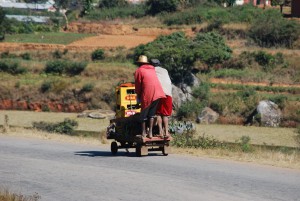
importance as non-motorized means of transport. They are significantly smaller than the large carts and can accordingly also be move forward more easily. The Varambas come in distinctly different designs with three or four wheels as well as an individually sophisticated mechanism with which they can be steered and braked. In the south of the country, it is often for water transport that the varambas are used, whereas in the highlands they are used to transport all sorts of things. If you want to use your Journey through Madagascar you will quickly realize that the conditions on the island are different to 100% than you are used to in Europe. In many places we can help you to better understand local customs, habits and traditions. This will give you your Madagascar vacation significantly easier. Just contact us, because we not only take care of the organization of your trip, but also prove ourselves directly on site during the implementation of your tour as a ideal contact person and experienced companion.

